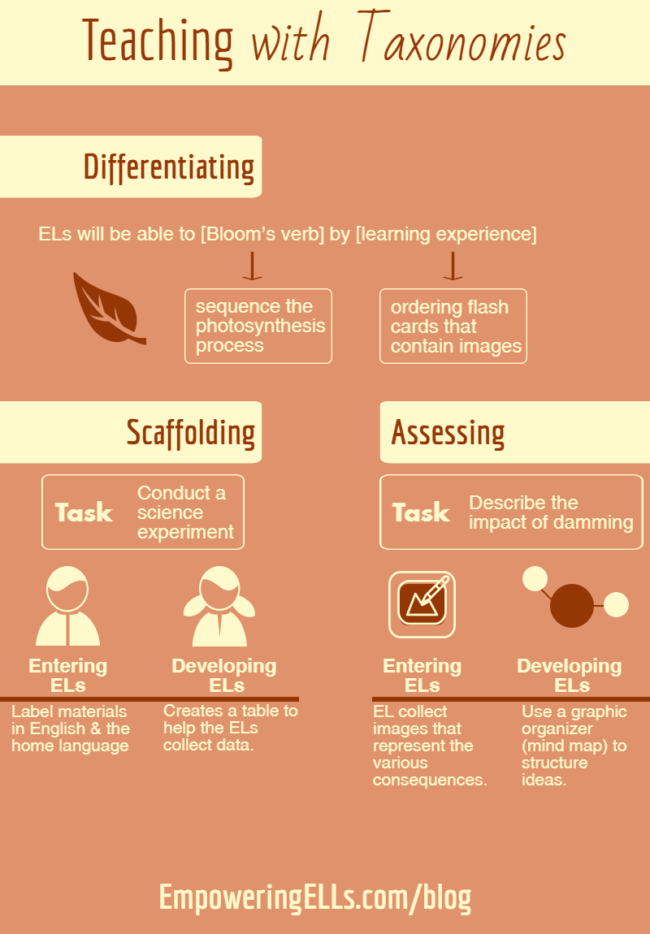This article on teaching with Bloom’s taxonomy was first published on Classroom Q & A with Larry Ferlazzo on March 1, 2017.
Education taxonomies such as Bloom’s and SOLO are not just colorful posters we hang on the wall. They frame my approaches to differentiation and scaffolding. Additionally, they serve as effective formative assessment tools. Because these taxonomies categorize thinking, they do offer practical ways to meet ELLs’ needs.
Differentiating with Taxonomies
Planning with Bloom’s is like working out in the gym. Pretend that you are a physical trainer; each client has different skill sets and needs a personalized plan. One client needs to develop better form, so you have them use machines to guide their movements. Another client has mastered form, so you offer dumbbells to provide more creative exercises.
Similarly, planning with Bloom’s allows teachers to think about offering different learning experiences that align to a particular skill set. Take for instance a science teacher who wants to differentiate instruction for his ELLs.
For his students who are still trying to Understand concepts, he might design an activity where ELs draw diagrams to visually explain concepts. ELs who already possess this level of understanding are asked to Create a lab experiment to test a hypothesis. These students are taking knowledge they have already internalized and applying it to new situations.
To differentiate learning experiences, use the thinking verbs at different levels of Bloom’s to construct the objective for each learning experience. This format is structured as: students will be able to [verb from Bloom’s] by [learning experience]
Scaffolding with Taxonomies
Bloom’s can also be used to scaffold instruction because the categorization clearly defines the thinking at each level. If teachers can identify students’ level of thinking, then instruction can be scaffolded to meet their individual needs. Returning to the science example, the teacher has to determine what language is needed to help students Understand concepts. Vocabulary is often the key to helping students understand, so direct vocabulary instruction is required at this level. For students at the Create level, prediction-making language is needed. The science teacher, therefore, can offer a sentence stem such as: If…, then…because….
To scaffold using Bloom’s, determine the language needed to process and communicate at each level. Create scaffolds that support the language demands to be proficient at each level of thinking.
Using Taxonomies to Assess Learning
Bloom’s also serves as an assessment tool when the data gathered from a formative assessment shapes the learning activities. Lets use the science teacher example again.
The teacher ultimately wants ELs to independently design a lab experiment, but first, he wants students to create one collaboratively with people from their table groups as a formative assessment. He notices that some ELs are struggling to successfully create one even with the support of classmates. His formative assessment of ELs’ knowledge reveals that they lack understanding of key concepts such as independent, dependent, and controlled variables.
With this data, he knows they are stuck at the Understanding phase, but the learning experience is at the Applying phase. He’ll have to reteach these students conceptual language before they can be expected to apply it to designing their lab experiments. To use Bloom’s as a form of assessment for learning, clearly identify the cognitive skills of each activity and be prepared to push ELs to the next level if they demonstrate mastery or scaffold if they are showing signs of frustration.
Conclusion
Because ELs come to us with a wide range of language mastery, using taxonomies such as Bloom’s supports differentiation, scaffolding, and assessment.
We can and should use these taxonomies because when teaching moves from a “one-size-fits-all” approach to a more personalized style of instruction, then students become the center of our focus and not just a program or a curriculum.


